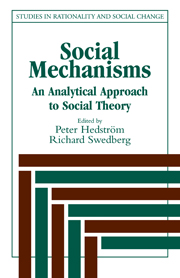Book contents
- Frontmatter
- Contents
- ACKNOWLEDGMENTS
- LIST OF CONTRIBUTORS
- 1 Social mechanisms: An introductory essay
- 2 Social mechanisms and social dynamics
- 3 A plea for mechanisms
- 4 Real virtuality
- 5 Concatenations of mechanisms
- 6 Do economists use social mechanisms to explain?
- 7 Social mechanisms of dissonance reduction
- 8 Social mechanisms without black boxes
- 9 Is sociological theory too grand for social mechanisms?
- 10 Theoretical mechanisms and the empirical study of social processes
- 11 Monopolistic competition as a mechanism: Corporations, universities, and nation-states in competitive fields
- 12 Rational imitation
- AUTHOR INDEX
- SUBJECT INDEX
12 - Rational imitation
Published online by Cambridge University Press: 24 March 2010
- Frontmatter
- Contents
- ACKNOWLEDGMENTS
- LIST OF CONTRIBUTORS
- 1 Social mechanisms: An introductory essay
- 2 Social mechanisms and social dynamics
- 3 A plea for mechanisms
- 4 Real virtuality
- 5 Concatenations of mechanisms
- 6 Do economists use social mechanisms to explain?
- 7 Social mechanisms of dissonance reduction
- 8 Social mechanisms without black boxes
- 9 Is sociological theory too grand for social mechanisms?
- 10 Theoretical mechanisms and the empirical study of social processes
- 11 Monopolistic competition as a mechanism: Corporations, universities, and nation-states in competitive fields
- 12 Rational imitation
- AUTHOR INDEX
- SUBJECT INDEX
Summary
Introduction
A few years ago I traveled by car from Stockholm to Copenhagen. It was a long and rather tiresome drive, and in order to stay alert, I started observing and classifying the behavior of my fellow travelers on the road. After a while, a curious fact caught my attention. While the cars around me on the multilane highway normally drove at some 100 to 105 kilometers per hour, they would all frequently and suddenly reduce their speed, as if instructed to do so by an invisible authority, although nothing prevented the cars from passing one another. Soon thereafter they returned to normal speed, but after a while, the same phenomenon occurred again: The cars suddenly slowed down, only to resume their original speed a short while later.
Having observed this pattern of behavior a number of times – a pattern referred to as “wolf-pack behavior” by American state troopers – it became evident to me that it had nothing to do with the driving conditions as such; it happened just as frequently under good conditions as under bad. Furthermore, the pattern of behavior had a clear social structure. What at first appeared to be an instantaneous reaction of all drivers to an instruction arriving from a central but invisible authority, upon closer examination appeared to be a contagious social process set in motion by one car suddenly reducing its speed.
- Type
- Chapter
- Information
- Social MechanismsAn Analytical Approach to Social Theory, pp. 306 - 328Publisher: Cambridge University PressPrint publication year: 1998
- 52
- Cited by



